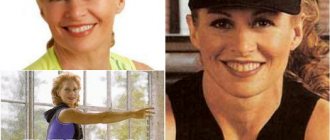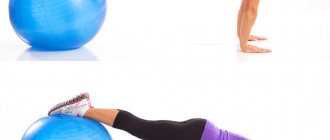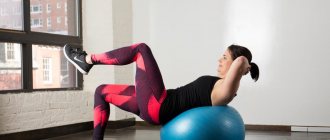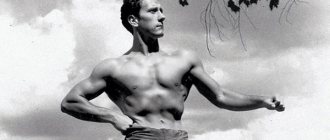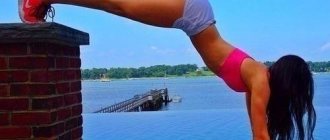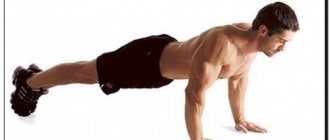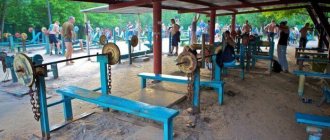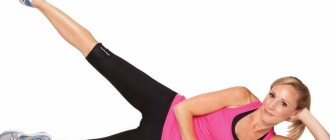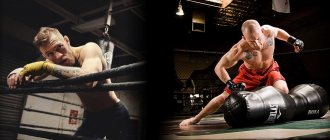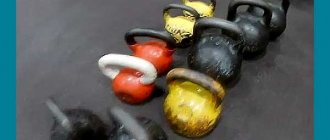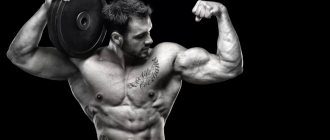Basic exercises have their name for a reason. They should be the basis of an athletes training program. The rest of the exercises only complement them. But bodybuilding is improving and new information is emerging. Today we will talk about new discoveries in multi-joint exercises in bodybuilding. If you focus on basic movements, you will definitely progress. This applies not only to weight gain, but also to strength parameters. For example, if you do squats, the progress will be much greater than if you replace it with others.
Single-joint movements
Also called isolated movements, these exercises focus on movement in one joint.
Examples:
biceps curls, leg extensions, leg curls and almost all exercises performed on machines. If the purpose of the exercise is to “work” a specific muscle group (for example, the middle deltoid or the short head of the biceps), these are single-joint movements.
Technique for performing a chest push while standing in fitness
This is an excellent movement for developing the muscles of the shoulder, legs and back.
On average, an athlete can gain more than ten kilos of quality mass in a year thanks to the chest press. Of course, for this it is necessary to perform it in strict accordance with the technique and take it seriously. This movement is quite popular in weightlifting, where it is divided into two phases when performed. First you need to lift the projectile onto your chest, thereby working the muscles of the legs and back, and then perform a push for the shoulder girdle. Now we will talk about the technique of this magnificent movement.
Stage 1
Squat down into the position you want to take when performing a deadlift. The only difference is the grip. In this case, it is necessary to use a different grip. Make sure your back is straight and there is a natural arch in your lower back. Lift the projectile using only the force of your legs. After the bar passes the knee joints, detonate the projectile.
Stage 2
Straighten your body and use your shoulders to give the projectile momentum to move upward.
Stage 3
Turn your hands and sit under the projectile. Be careful, as the bar may already begin to move downwards. After taking the projectile to your chest, straighten up completely.
Stage 4
Bend your knees and push upward, working not only with your arms, but also with your legs. Raise the apparatus above your head and lower the barbell. The entire movement is performed without pauses between stages.
Multi-joint movements
They are also called basic or compound movements; These exercises require the coordinated work of many levers and joints to move the load.
Examples:
Free weight exercises such as squats, deadlifts, barbell rows, barbell and dumbbell presses, and pull-ups. If you experience soreness and fatigue in multiple muscle groups the day after performing a movement, it is most likely a multi-joint movement.
Hypertrophy and single-joint movements
Mechanical stress, load volume and calories cause muscles to grow. This is a simplified explanation, but I prefer it to most other explanations because it is clear and easy to put into practice.
If you're looking to build muscle using this regimen, it's clear that the high-impact exercises that create the most mechanical (muscle) tension use the most muscles. Think about how many joints and muscles are involved in squats, deadlifts, presses and rows. There is nothing supernatural in these movements. Yes, they are difficult and complex, but when performed correctly, they create such a load on the muscles that no isolated exercise can compare.
This is also true in relation to the load volume. To achieve the kind of muscle growth stimulation that heavy compound movements provide, you will need an unrealistic amount of single-joint exercises.
Without exception, all compound movements are the most effective use of the precious time you spend in the gym.
The best compound exercises for gaining mass
Source: fatalenergy.com.ru
Autumn and the approaching winter make many athletes and ordinary gym goers think that the time has come to gain weight, which can be “dried out” in the spring, getting a more attractive and functional body.
If your biorhythms coincide with gaining weight in the winter, then this option is certainly worth considering. The point is that there are people who are uncomfortable working for weight in winter, and they prefer to “dry out” in the cold season. This may sound strange, but it is true. If you have decided that this autumn and winter should become a time of large-scale acquisitions among the masses, then this material is published especially for you.
The portal FATALENERGY.COM.RU reminds you that when it comes to gaining weight, there are different options for solving the problem. You can solve this problem more subtly, let’s say, even with jewelry, or you can eat everything that is not nailed down, gaining too much fat and too small a percentage of meat. We must not forget that getting rid of the accumulated fat will not be so easy later, because you will also have to say goodbye to a certain percentage of the honestly eaten muscle mass. Someone will say that this is a natural process and they will be right, but in this case we are talking about minimizing the percentage of lost muscles as much as possible.
Include these exercises in your training program, which will be complemented by a proper diet, and you can achieve good results in gaining lean muscle mass. When trying exercises for the first time and learning the technique, do not take heavy weights, because there is a high chance of getting injured or learning the technique of performing the movement incorrectly.
Thrusters with a bar
This exercise is known to many (especially CrossFit followers) as an exercise performed with dumbbells. By taking a barbell instead of dumbbells, you can work not so much on coordination as on mass and strength, because a more stable apparatus allows you to take more weight.
- load the Olympic bar with the desired weight;
- pull the bar onto your chest, observing the technique;
- then begin to squat, bending your hips and knees, passing your thighs between your legs;
- maintain a vertical body position with a straight back (go down as low as you can, observing the conditions described above);
- at the bottom of the squat you will need to give your body an impulse in order to get up and do a bench press;
- Starting the next repetition, return the weight to your shoulders.
Power clean
This exercise will bring a lot of benefits and will allow you to learn the elements that weightlifters use in their training.
— the barbell is located on the floor, grab it with a grip in close proximity to the plates (snatch grip);
- lower your hips with the weight focused on your heels, back straight, head looking straight ahead, chest, and shoulders located directly in front of the bar;
- pull the barbell up, including your knees;
- the angle of your back should remain the same, and your arms should remain straight;
- when the bar approaches the middle of the thigh, you need to accelerate in order to pull the bar upward with the strength of your legs;
- then use a “shrug” type movement and bend your elbows up and out;
- when the bar “flies up” you need to sit under it, placing your hands under the bar and putting your elbows forward;
- The final position in this exercise is you stand with the barbell resting on your front deltoids.
The power clean is a more complex exercise than thrusters, but mastering it will allow you not to worry about the lack of racks in the gym when you need to do a standing press or a push press. If you have the opportunity, ask an experienced coach or athlete to show you the technique and also correct the way you perform the exercise.
Strength and single-joint exercises
Although strength is most often symbolized by flexed biceps, strength is largely determined by nerves rather than muscles. Muscle tissue is able to withstand load only when the central nervous system and its signaling systems in the periphery command the muscles to generate force. To train the brain and motor centers of the central nervous system, you need powerful stimuli that require rapid response. But this is much simpler than nuclear physics. All you have to do is lift the heavy load quickly.
Although strength is most often symbolized by flexed biceps, strength is largely determined by nerves rather than muscles.
Heavy loads are incompatible with isolation exercises. I'm sure you can find a weight that makes bicep curls extremely challenging, but it won't be a real test for your nervous system.
Biceps curls may stimulate local muscle growth and increase muscle resistance to stress, but the impulse the brain receives will not be the emergency alarm that screams, “Look out!” Consequently, you will not receive the impulse without which it is impossible to develop real strength in all muscle groups.
Athleticism and single-joint exercises
Body parts are not isolated from each other. Every muscle, joint, tendon and bone is part of a system that in turn makes up an even larger system. The only reason we call the biceps or hamstrings muscles independent motor units is because of the curiosity of the ancient Greeks, who isolated these structures during the process of dissecting a corpse.
It is enough to look at the human body as a unified and global motor system, and not as isolated motor units in an anatomical atlas, and it becomes obvious that muscles and joints do not work alone. We move using a complex joint system that extends from head to toe. And while artificial devices such as exercise rollers do not isolate the joint, natural movement will require the involvement of many joints throughout the body.
Single-joint movements are often performed in a sitting or lying position, and the movement is performed in one joint along a simple trajectory, which is never seen in everyday physical activity. In sports, we also move freely in space without any external stabilizers such as benches, seats or nautilus machines.
Almost all athletes became bigger and stronger when they abandoned single-joint exercises for high training loads
Think about it and ask yourself what makes more sense - squats or leg extensions? You know the answer.
Putting the principle into practice
- Start training a specific muscle with a single-joint exercise. First, do 1-2 warm-up sets with light weights. Then set your working weight, but add another 5-8% of the load - after all, you are now doing the exercise first, and you have more strength.
- For the next multi-joint exercise, you need to take less weight than usual. By the way, after a single-joint exercise, such a weight may seem even heavier to you. This circumstance makes this technique indispensable for fitness athletes with injuries. If you have knee pain, heavy squats would be dangerous and would aggravate the pain. Well, after single-joint extensions, you will squat with a lighter safe weight.
- There is no need to set strength records in a single-joint exercise. 10-12 repetitions per set are enough until you feel a burning sensation in the muscle.
- You can do all the sets of the single-joint exercise first and then move on to the multi-joint exercise. However, you can do it differently. Combine single-joint and multi-joint exercises into supersets. Do the single-joint set first and then move on to the multi-joint set without resting. You will rest between such paired supersets.
- You will do multi-joint exercises at the end of your workout, when fatigue has already taken its toll. To avoid injury, perform them under the supervision of a trainer. There is another way out: do multi-joint
Multi-joint exercises produce the greatest hormonal response. For this reason, they are effective for gaining weight. Learn about new discoveries in fitness.
If you focus on basic movements, you will definitely progress. This applies not only to weight gain, but also to strength parameters. For example, if you do squats, the progress will be much greater than if you replace it with others.
There is no substitute for lifting weights
If you're a competitive bodybuilder and you really need a big biceps peak for an upcoming performance, you'll definitely benefit from some single-joint exercises. But for most of us, they are simply not necessary.
I can't talk to every athlete, but many people choose single-joint exercises because:
- They think that presses or curls can be a substitute for complex multi-joint exercises; or
- They want to develop a specific muscle group or tighten lagging muscles to improve strength in basic exercises.
An example of the latter would be people who believe that doing leg extensions on a machine will help them with squats, or that they will be able to get more pull-ups after working their biceps directly. However, the truth is that simply increasing the volume of the compound exercises is a much more effective solution to this problem.
I know from personal experience that almost all athletes became bigger and stronger when they abandoned single-joint exercises for high training loads. Your body doesn't care about biceps, triceps or quads. It only assesses the intensity of the stress factor and adapts to the load, and therefore, well-chosen compound exercises with a high load are best suited for accelerating muscle growth.
And to help you get to your goal faster, I'll list my favorite compound exercises to replace popular single-joint exercises.
Instead of bicep curls, do pull-ups
Most rowing movements place stress on the biceps, but pull-ups are the most effective and powerful of all rowing variations. Pull-ups develop massive arms and a strong back at the same time, so they're a great, win-win option.
Pull-ups
Instead of doing delt raises, do presses
The bench press and overhead press hit the deltoids. After the military press or bench press, do not rush to focus on working your deltoids, but add a couple of sets of bench presses and give your deltoids a heavy load.
Instead of leg curls - Romanian deadlift
To lift heavy loads and develop an athletic physique, you need strong muscles in the back of your torso. PCT trains the hamstrings to become larger and stronger while standing, which is much more applicable in sports and everyday life than bending the knees while sitting or lying down.
Instead of leg extensions - front squats
Squats are the king of lower body exercises. Many guys spend years perfecting their squat skills but fall short of success by neglecting the front squat.
When performed correctly, front squats are a safe movement that generates significant force, which is many times more effective than endless leg extensions in a machine.
What exercises should I do?
Let's look at the most effective exercises for each muscle group.
More: Top 10 best anti-snoring remedies
It is worth understanding that this article deals specifically with mass-gaining exercises, for building a “framework” of muscles; for other purposes, it may be other exercises.
Legs
Squats
The foundation of the basics, an excellent exercise for the leg muscles and for gaining mass in general. No matter how fantastic it may sound, if you squat with a barbell and do no other exercises, your upper body muscles will also grow. Up to certain limits, of course. Squats should be your main leg exercise. Depending on the placement of the legs during the exercise, the emphasis of the load will shift. With a wide stance, the gluteal muscles receive more load; with a narrow stance, the quadriceps work more. During heavy squats, a large amount of anabolic hormones are produced, which makes this exercise very effective.
Leg press
This is a more focused exercise for training the quadriceps. Due to the lack of axial load, it can be a replacement for squats for spinal injuries.
The emphasis of the load shift will depend on the positioning of the feet on the platform. Some athletes use huge weights in this exercise and work in a very short amplitude, which can only be justified at advanced stages. At the initial and middle stages, it is necessary to work with normal (not extreme) weights and full amplitude.
Deadlift on straight legs
An exercise for training the hamstrings, in which it is important to feel the muscle contraction in the target muscle, otherwise it is not the legs that are trained, but the back, as with a deadlift.
Standing calves
The calf muscles are the heaviest in terms of response to load. They need to be trained with a large number of repetitions due to the very small amplitude. The working weight should also be large. You can alternate performing the exercise while standing and sitting. When performing while sitting, the soleus muscle works; it is located under the gastrocnemius, and when enlarged, it pushes it out, giving the calves a peak.
Back
Bent-over barbell row or T-bar row
A very effective exercise for the thickness of the latissimus muscle. The tilt of the body is important, 30° is considered optimal, but everything is individual, you should only focus on muscle feeling. It is necessary to minimize the involvement of the biceps in the work; to do this, you need to concentrate not on the projectile, but on moving your elbows as far back as possible.
Pull-ups or vertical block rows
The main exercise for back width. If you do pull-ups more than 12-15 times, you need to hang weights. It is important to choose the correct grip width. With a wide grip, the work of the biceps is well isolated and only the latissimus muscles we need work, but the amplitude is short. With a narrow grip, the opposite is true, the amplitude is maximum, but the biceps greatly steals the load. It is worth experimenting with the width of your grip; the optimal one will most likely be medium or slightly wider than average. We are training the back, so the grip should be straight (palm facing the bar); with a reverse grip, most of the load goes into the biceps.
More: Top 10 best nasal drops for runny nose and congestion
Horizontal block thrust
In this exercise, you can work out the bottom of the latissimus muscles well; to do this, you need to pull the handle as if to the groin.
You need to pull with your back, not with your arms; to do this, you need to think again about your elbows, trying to bring them as far back as possible. For greater concentration, you can work in turns with one hand. A similar exercise is the one-arm dumbbell row, in which you can feel the muscle very well.
Breast
Bench press
A classic of the genre, the best exercise for the pectoral muscles. There are many options for inclining the bench; it is believed that the best is an upward tilt of 20-30°, in which all the muscle fibers of the pectoral muscles work evenly. However, the most popular is definitely the bench press on a horizontal bench, since in this position it is possible to work with a lot of weight. The inclusion of the triceps in the work will depend on the width of the grip. The wider the grip, the more isolated the chest works, but at the expense of amplitude, and vice versa, a narrow grip gives greater amplitude, but the triceps are strongly involved. At the top point, the arms do not need to be fully extended, otherwise the load will be removed from the target muscle. All movements are smooth, without rebound. You can do it with dumbbells, the amplitude will be greater, but you will have to sacrifice weight.
Hummer press
The principle is the same as in the bench press, but due to the fixed trajectory of the projectile, you can concentrate more on muscle contraction.
Hands
Barbell curl
In fact, this is an isolated exercise, bending occurs only in the elbow joint, but for the biceps, almost all effective exercises are single-joint, with the exception of pull-ups with a reverse grip, but due to the inclusion of the back in the work, it is unlikely that you will be able to achieve maximum muscle contraction. PSHNB is the main “basic” exercise for the biceps, which, depending on the grip width, will allow you to work all the bundles of the biceps muscle.
Hammer curls
In addition to the biceps, the forearm and brachialis (the muscle located under the biceps) are included in the work. Movements should be smooth, without swaying the arms and body, only the muscles should work.
Close grip barbell press
A basic exercise for triceps, in which it is important to feel the muscle contraction, otherwise the chest will work. A narrow grip does not imply contact of the hands; the position of the hands must be chosen in such a way that the work of the triceps is best felt. The elbows should be pressed to the body, trying to make movements primarily in the elbow joint.
More: How to treat prostatitis - the best remedies
Dips
Here it is important to maintain a straight body position and not lean forward. The main movement should occur in the elbow joint, which at the lowest point should not be bent more than 90°. Work occurs in the upper part of the amplitude. You need to hang weights if you can do 12-15 repetitions without weight.
Shoulder exercises
Dumbbell Pull
An excellent exercise for working the middle and back of the deltoid muscles, which give visual width to the shoulders. A very underrated exercise. With the correct technique, the amplitude is relatively short, the number of repetitions should be correspondingly large.
Standing chest press
The main exercise for the anterior deltoids. Grip shoulder-width apart, movements are smooth, without the help of legs.
At the top point, we do not fully extend our arms, otherwise the load will go into the triceps and joint. During the upward movement, you need to mentally raise your elbows, not the barbell, this is how the delta will work, with minimal involvement of the triceps. If you take dumbbells instead of a barbell, the amplitude increases, but the working weight drops. This exercise can also be performed in a Smith machine.
Shrugs with dumbbells.
An exercise to train the trapezius, which is performed with heavy weight due to its very small amplitude. Some athletes don't train the trapezius at all because it is statically loaded in many exercises. If you want to get injured, you can rotate your shoulders while performing this exercise, but if not, then the movement of your shoulders should be strictly up and down. At the top point, you can pause briefly for peak contraction.
Basic exercise training program
Day 1
Barbell squats rest: 120 seconds
4
sets of
5
reps
Front squats rest: 90 seconds
3
sets of
6
reps
Superset:
Kettlebell squats (goblet) rest: 60 seconds
3
sets of
10
reps
Back lunges with dumbbells (reverse lunges) rest: 60 seconds
3
sets of
8
reps
Day 2
Bench press rest: 120 seconds
4
sets of
5
reps
Dumbbell bench press rest: 90 seconds
3
sets of
6
reps
Superset:
Bent-over rows rest: 60 seconds
3
sets of
10
reps
Bent-over dumbbell rows rest: 60 seconds
3
sets of
8
reps
Day 3
Barbell deadlift rest: 120 seconds
4
sets of
5
reps
Power rack row rest: 90 seconds
3
sets of
6
reps
Superset:
Romanian deadlift rest: 60 seconds
3
sets of
10
reps
Romanian single leg deadlift;
rest: 60 seconds 3
sets of
8
reps
Day 4
Military Press Rest: 120 seconds
4
sets of
5
reps
Seated dumbbell press rest: 90 seconds
3
sets of
6
reps
Superset:
Pull-ups rest: 60 seconds
3
sets of
10
reps
Rows to face rest: 60 seconds
3
sets of
12
reps
